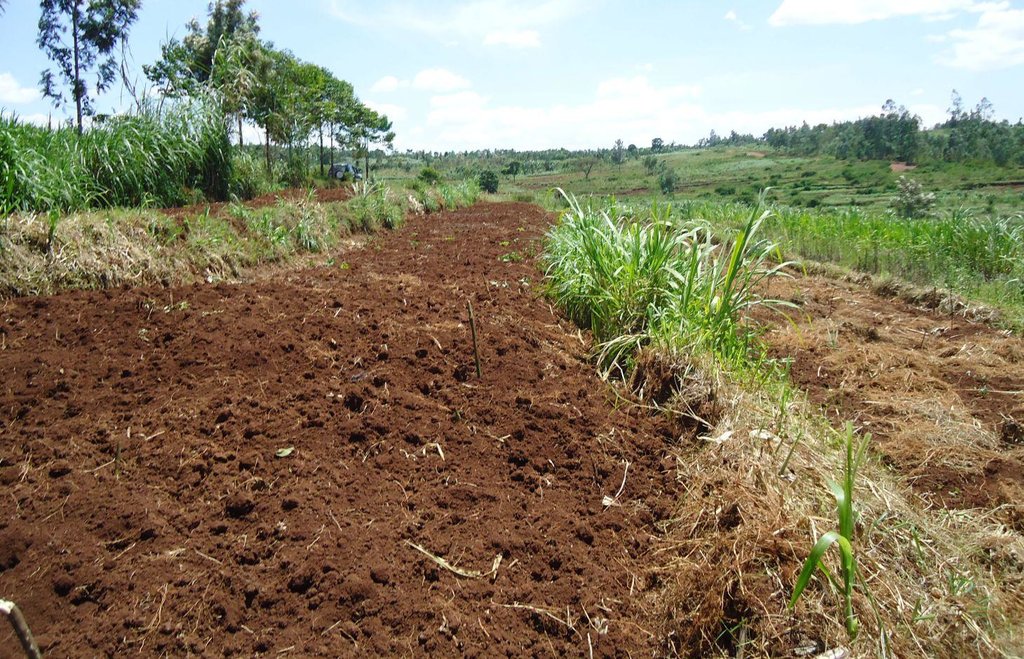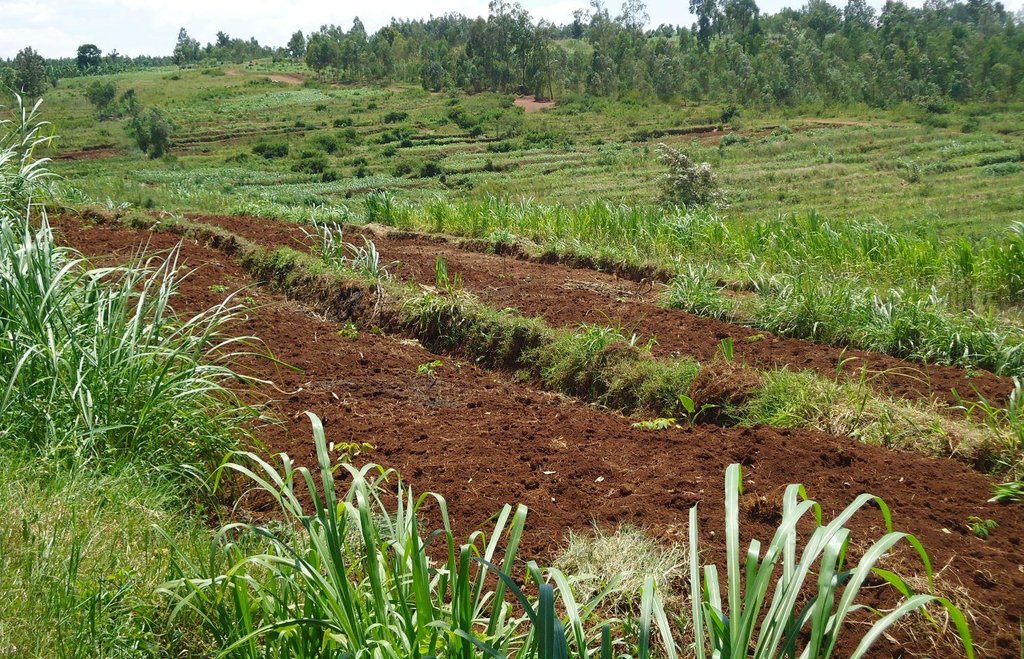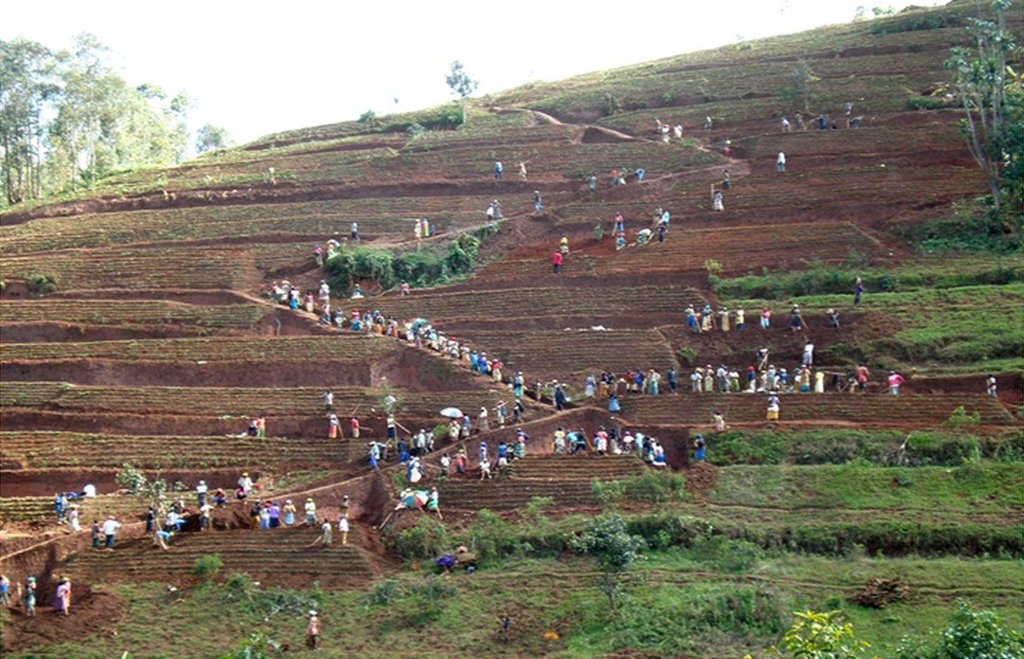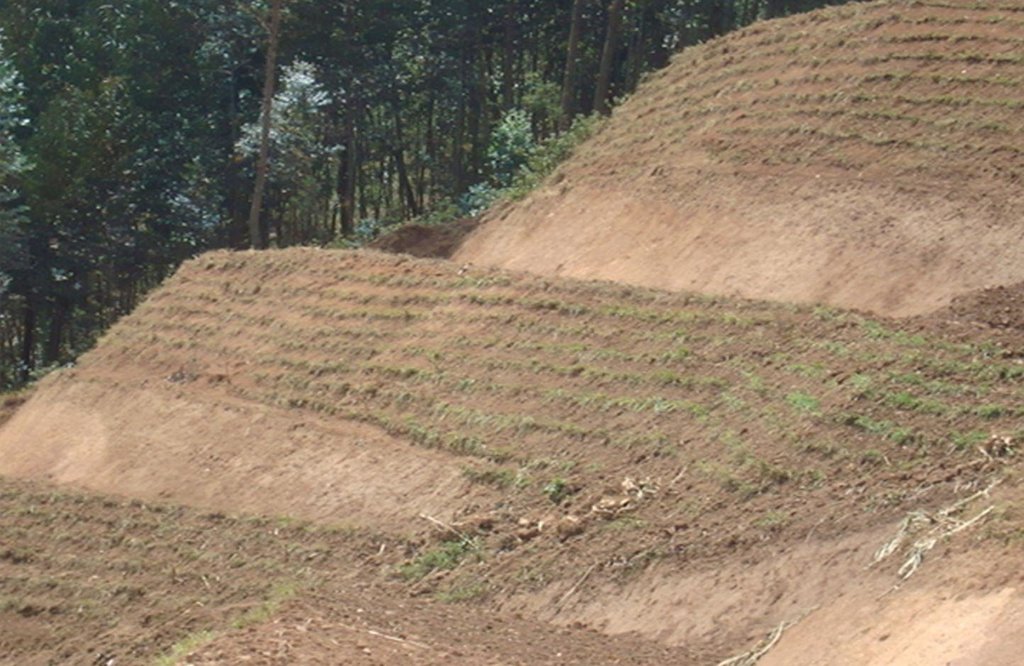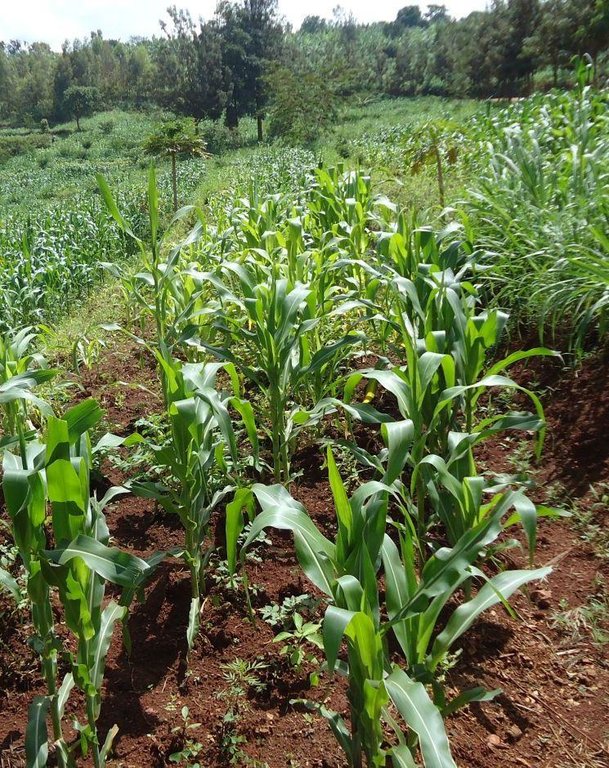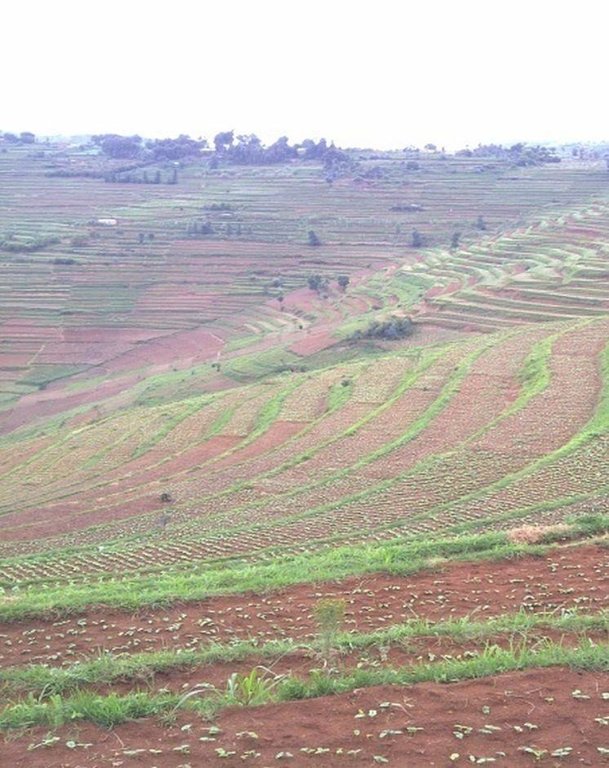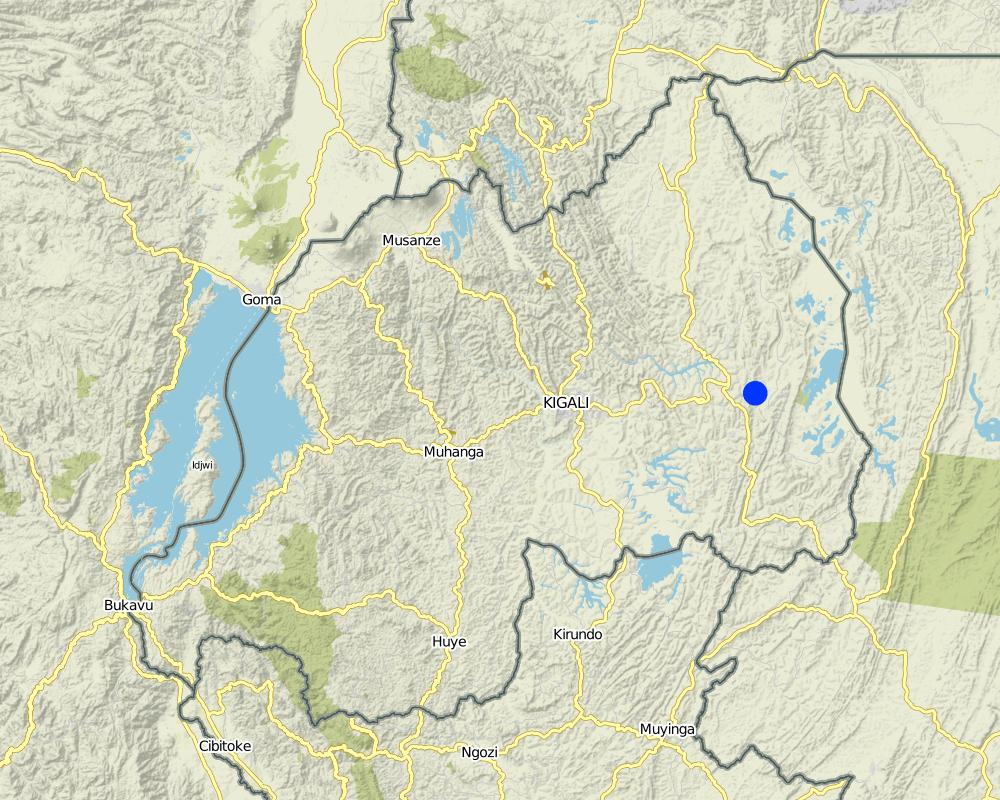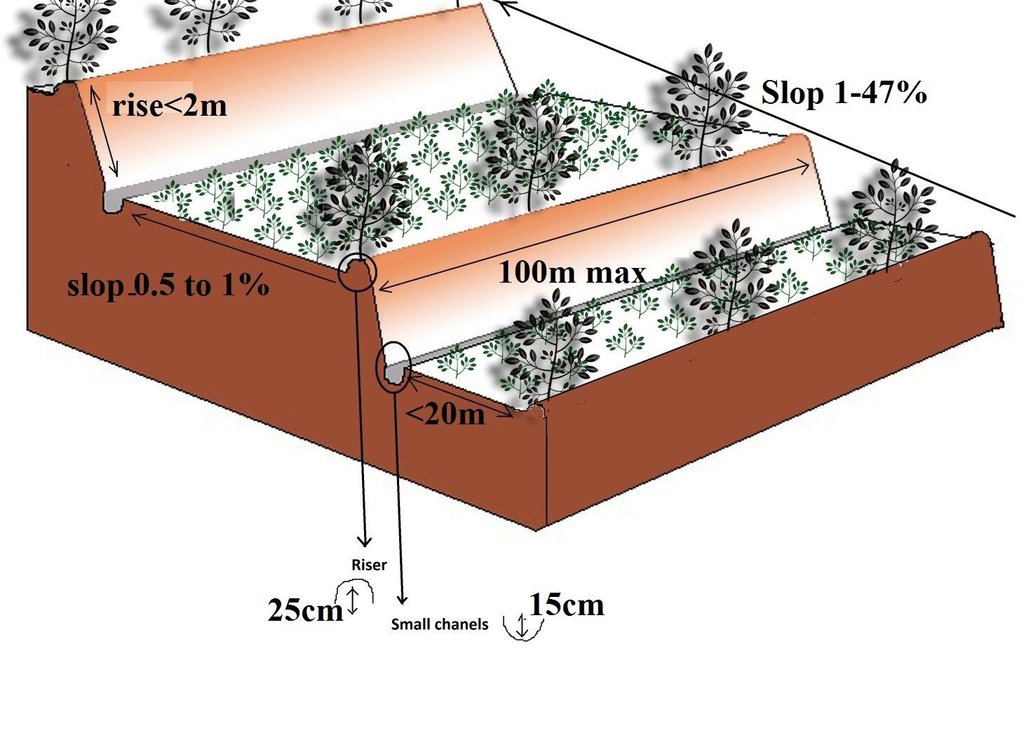Radical Terraces [رواندا]
- تاريخ الإنشاء:
- تحديث:
- جامع المعلومات: Desire Kagabo
- المحرر: –
- المراجعون: David Streiff, Alexandra Gavilano
Amaterasi y'indinganire
technologies_1553 - رواندا
عرض الأقسام
توسيع الكل طي الكل1. معلومات عامة
1.2 تفاصيل الاتصال بالأشخاص الرئيسيين لمصدر المعلومات والمؤسسات المشاركة في تقييم وتوثيق التقنية
متخصص في الإدارة المستدامة للأراضي:
متخصص في الإدارة المستدامة للأراضي:
اسم المشروع الذي سهّل توثيق/تقييم التقنية (إذا كان ذلك على صلة)
The Transboundary Agro-ecosystem Management Project for the Kagera River Basin (GEF-FAO / Kagera TAMP )اسم المؤسسة (المؤسسات) التي سهلت توثيق/تقييم التقنية (إذا كان ذلك على صلة)
Food and Agriculture Organization of the United Nations (FAO) - إيطاليااسم المؤسسة (المؤسسات) التي سهلت توثيق/تقييم التقنية (إذا كان ذلك على صلة)
Rwanda Agriculture Board (Rwanda Agriculture Board) - رواندا1.3 الشروط المتعلقة باستخدام البيانات الموثقة من خلال WOCAT
يوافق جامع المعلومات والشخص (لاشخاص) الرئيسي لمصدر المعلومات على الشروط المتعلقة باستخدام البيانات الموثقة من خلال WOCAT:
نعم
1.5 الإشارة إلى الاستبيان (الاستبيانات) حول مناهج الإدارة المستدامة للأراضي (موثقة باستخدام WOCAT)

Top down approach [رواندا]
This is a top down approach to technology development and dissemination with limited involvement of intended beneficiaries.
- جامع المعلومات: Desire Kagabo
2. وصف تقنيةالإدارة المستدامي للأراضي
2.1 وصف مختصر للتقنية
تعريف التقنية:
Locally referred to as ‘radical terracing’, the method involves earth moving operations that create reverse-slope bench terraces which have properly shaped risers stabilized with grass or trees on embankment to avoid collapse.
2.2 وصف تفصيلي للتقنية
الوصف:
In Rwanda, a unique method of back-slope terracing originally introduced by missionaries growing wheat in the Northern Province in the 1970s, has been widely adopted by smallholder farmers in many parts of the country. The farmers are careful to isolate the topsoil, then they re-work the subsoil to create the required reverse-slope bench, after which the topsoil is spread over the surface. The riser is planted with short runner grass for stabilization, all within the same day. Radical terracing is usually done manually with hoes and shovels, mostly by communal group-work involving hundreds of farmers (see left photo). Thus, a hillside can be terraced in one day. Where radical terraces have been constructed, the effects have been dramatic, achieving optimum water and soil conservation on slopes exceeding 50%, while adoption rates have been quite extensive. This high adoption of radical terracing is related to the existing policies and programs such as land consolidation, land management and crop intensification programs. These policies/programs boost the use of radical terraces by providing farmers more opportunities to easily access inputs such as improved seeds and manure for increasing the productivity of constructed radical terraces. Recent studies (e.g. Fleskens, 2007, Bizoza and de Graaff 2012 and Kagabo et al. 2013) assert that radical terraces in the highlands of Rwanda are only financially viable when the opportunity cost of labour and manure are below the local market price levels and when agriculture area on these radical terraces can be substantially intensified. Ten to 30 metric tons of manure (organic) are required to restore the soil fertility of newly established radical terraces.
Purpose of the Technology: In Rwanda, radical terraces are principally designed (1) to reduce soil losses through enhanced retention and infiltration of runoff, (2) to promote permanent agriculture on steep slopes and (3) to promote land consolidation and intensive land use.
Establishment / maintenance activities and inputs: Newly established radical terraces should be protected at their risers and outlets, especially in the first or second year of the establishment. After establishing a terrace, a riser is shaped and grasses or shrubs/trees are planted soon after. Napier grass is commonly planted and is used as forage for livestock. Risers on radical terraces are seen as a new production niche of forage as a result of land shortage and a strict zero grazing policy.
Natural / human environment: Radical terraces have the potential of improving farmers’ livelihoods and increasing the resilience of a degraded environment.
2.3 صور التقنية
2.5 البلد/المنطقة/المواقع التي تم تنفيذ التقنية فيها والتي يغطيها هذا التقييم
البلد:
رواندا
المنطقة/الولاية/المحافظة:
Rwanda
مزيد من التفاصيل حول الموقع:
Kayonza District (Eastern province)
حدد انتشار التقنية:
- منتشرة بالتساوي على مساحة
إذا كانت التقنيةا موزعة بالتساوي على منطقة ما، حدد المساحة المغطاة (بالكيلومتر المربع):
10,3
التعليقات:
Total area covered by the SLM Technology is 10.3 km2.
Map
×2.6 تاريخ التنفيذ
في حالة عدم معرفة السنة بالتحديد، يرجى الإشارة إلى التاريخ التقريبي:
- منذ أقل من 10 سنوات (مؤخرًا)
2.7 إدخال التقنية
- Government
التعليقات (نوع المشروع، الخ):
The Government introduced it through local leaders and agronomist. It was established in 2004
3. تصنيف تقنية الإدارة المستدامي للأراضي
3.1 الغرض الرئيسي ( الأغراض الرئيسية) للتقنية
- الحد من تدهور الأراضي ومنعه وعكسه
3.2 نوع (أنواع) استخدام الأراضي الحالية حيث يتم تطبيق التقنية

الأراضي الزراعية
- زراعة سنوية
- زراعة معمرة (غير خشبية)
الزراعة السنوية - حدد المحاصيل:
- المحاصيل الجذرية/الدرنية - البطاطا الحلوة، واليام، والقلقاس/الكوكويام، وغيرها
الزراعات المعمرة (غير الخشبية) - حدد المحاصيل:
- أناناس
عدد مواسم الزراعة في السنة:
- 2
حدد:
Longest growing period in days: 120; Longest growing period from month to month: September- January; Second longest growing period in days: 90; Second longest growing period from month to month: March - June
التعليقات:
Major cash crop: Sweet potato and pineapple
Major land use problems (compiler’s opinion): Soil erosion due to high runoff on the steep slopes, deforestation, intensive cultivation and lack of suitable land management methods.
Major land use problems (land users’ perception): Low crop production, soil erosion and lack of fodder
3.4 إمدادات المياه
إمدادات المياه للأرض التي يتم تنفيذ التقنية عليها:
- بعلية
3.5 مجموعةالإدارة المستدامة للأراضي التي تنتمي إليها هذه التقنية
- التدابير المتقاطعة للمنحدرات
3.6 التدابير التقنية في مجال إلادارة المستدامة للأراضي

التدابير النباتية
- V2: الأعشاب والنباتات العشبية المعمرة

التدابير البنيوية
- S1: المصاطب المتدرجة
التعليقات:
Type of vegetative measures: aligned: -contour
3.7 الأنواع الرئيسية من تدهور الأراضي التي تناولتها التقنية

تآكل التربة بالمياه
- الوزن(Wt): فقدان التربة السطحية/تآكل السطح
- (Wo:) تأثيرات التدهور من مواقع أخرى
التعليقات:
Secondary types of degradation addressed: Wo: offsite degradation effects
Main causes of degradation: over-exploitation of vegetation for domestic use, overgrazing (Grazing and fodder), other natural causes (avalanches, volcanic eruptions, mud flows, highly susceptible natural resources, extreme topography, etc.) specify (Extreme topography: steep slopes in many cases over 50%), population pressure (High density (in rural area over 400 inhabitant per ha))
Secondary causes of degradation: deforestation / removal of natural vegetation (incl. forest fires) (Use of cooking energy (fire wood)), poverty / wealth (Farmers have low income and have less access to off farm income or remittances), education, access to knowledge and support services (High rate of irriteracy)
3.8 منع أو حد أو عكس تدهور الأراضي
تحديد هدف التقنية فيما يتعلق بتدهور الأراضي:
- الحد من تدهور الأراضي
التعليقات:
Secondary goals: prevention of land degradation, rehabilitation / reclamation of denuded land
4. المواصفات الفنية، وأنشطة التنفيذ، والمدخلات، والتكاليف
4.1 الرسم الفني للتقنية
المواصفات الفنية (المتعلقة بالرسم الفني):
The farmers are careful to isolate the topsoil, then they re-work the subsoil to create the required reverse-slope bench, after which the topsoil is spread over the surface. The riser is planted with short runner grass for stabilization, all within the same period.
Location: Nyamirama. Kayonza/West/Rwanda
Date: 2013
Technical knowledge required for field staff / advisors: high (Special training should be provided to field staff to be able to make an adequate design)
Technical knowledge required for land users: moderate (Land users are required to only implement the technology under the supervision of field staff)
Main technical functions: control of concentrated runoff: retain / trap
Secondary technical functions: control of concentrated runoff: impede / retard, reduction of slope angle, reduction of slope length, increase of infiltration
Aligned: -contour
Vegetative material: G : grass
Number of plants per (ha): 2000
Vertical interval between rows / strips / blocks (m): 1
Spacing between rows / strips / blocks (m): 4
Vertical interval within rows / strips / blocks (m): 0.2
Width within rows / strips / blocks (m): 0.2
Grass species: Pennisetum
Slope (which determines the spacing indicated above): 35%
If the original slope has changed as a result of the Technology, the slope today is (see figure below): 0%
Gradient along the rows / strips: 0%
Terrace: bench level
Vertical interval between structures (m): 2
Spacing between structures (m): 4
Slope (which determines the spacing indicated above): 20-50%
If the original slope has changed as a result of the Technology, the slope today is: 0%
Lateral gradient along the structure: 0%
Vegetation is used for stabilisation of structures.
المؤلف:
Kagabo Desire and Ngenzi Guy, RAB, 5016 Kigali
4.2 معلومات عامة بخصوص حساب المدخلات والتكاليف
عملة أخرى/ عملة وطنية (حدد):
Rwandan francs
إذا كان ذا صلة، وضح سعر الصرف من الدولار الأمريكي إلى العملة المحلية (على سبيل المثال، 1 دولار أمريكي = 79.9 ريال برازيلي): 1 دولار أمريكي =:
640,0
اذكر متوسط تكلفة أجر العمالة المستأجرة في اليوم الواحد:
1000
4.3 أنشطة التأسيس
| النشاط | التوقيت (الموسم) | |
|---|---|---|
| 1. | Cuttings of grasses | Rain season |
| 2. | Transport of grass cuttings | Rain season |
| 3. | Planting of grass cuttings | Rain season |
| 4. | Land surveying (slope determination, soil structure and texture analysis) | any time |
| 5. | Construction of bunds (risers) with soil from upper and lower sides | dry season |
| 6. | Level terraces bed (surface soil moved from upper to lower part of terraces) | dry season |
| 7. | cutting subsurface soil, leveling and refilling surface soil | dry season |
| 8. | Make lips on edges of terraces | dry season |
| 9. | Compact risers | dry season |
| 10. | Plant grasses including agro-forestery trees. | rainy season |
| 11. | Input/ application of farmyard manure and liming | rainy season |
4.4 التكاليف والمدخلات اللازمة للتأسيس
| تحديد المدخلات | الوحدة | الكمية | التكاليف لكل وحدة | إجمالي التكاليف لكل مدخل | % من التكاليف التي يتحملها مستخدمو الأراضي | |
|---|---|---|---|---|---|---|
| العمالة | Cuttings of grasses | persons/day/ha | 2,0 | 1000,0 | 2000,0 | 60,0 |
| العمالة | Transport of grass cuttings | persons/day/ha | 10,0 | 1000,0 | 10000,0 | |
| العمالة | Planting of grass cuttings | persons/day/ha | 20,0 | 1000,0 | 20000,0 | 100,0 |
| العمالة | Land surveying (slope determination, soil structure and texture | persons/day/ha | 6,0 | 20000,0 | 120000,0 | |
| الأسمدة والمبيدات الحيوية | Lime | kg/ha | 2500,0 | 40,0 | 100000,0 | |
| الأسمدة والمبيدات الحيوية | Famyard manure | kg/ha | 30000,0 | 5,0 | 150000,0 | |
| الأسمدة والمبيدات الحيوية | Mineral fertilizers | kg/ha | 300,0 | 500,0 | 150000,0 | |
| غير ذلك | Labour: Construction of bunds | persons/day/ha | 100,0 | 1000,0 | 100000,0 | |
| غير ذلك | Labour: Level terraces bed | persons/day/ha | 250,0 | 1000,0 | 250000,0 | |
| غير ذلك | Labour: Cutting subsurface soil | persons/day/ha | 250,0 | 1000,0 | 250000,0 | |
| غير ذلك | Labour: Make lips on edges of terraces | persons/day/ha | 10,0 | 1000,0 | 10000,0 | |
| غير ذلك | Labour: Compact risers | persons/day/ha | 50,0 | 1000,0 | 50000,0 | |
| غير ذلك | Labour: Plant grasses including agro-forestery trees | persons/day/ha | 50,0 | 1000,0 | 50000,0 | |
| إجمالي تكاليف إنشاء التقنية | 1262000,0 | |||||
| إجمالي تكاليف إنشاء التقنية بالدولار الأمريكي | 1971,88 | |||||
التعليقات:
Duration of establishment phase: 1 month(s)
4.5 الصيانة/الأنشطة المتكررة
| النشاط | التوقيت/الوتيرة | |
|---|---|---|
| 1. | Weeding | Before crop planting/each cropping season |
| 2. | Manure application | Before crop planting/annually |
| 3. | Grass streaming | Throughout the year |
| 4. | Cleaning of channels and drains | through out the year |
| 5. | Regular repair of destroyed risers | through the year |
4.6 التكاليف والمدخلات اللازمة للصيانة/للأنشطة المتكررة (سنويًا)
| تحديد المدخلات | الوحدة | الكمية | التكاليف لكل وحدة | إجمالي التكاليف لكل مدخل | % من التكاليف التي يتحملها مستخدمو الأراضي | |
|---|---|---|---|---|---|---|
| العمالة | Weeding | persons/day/ha | 5,0 | 1000,0 | 5000,0 | 100,0 |
| العمالة | Manure application | persons/day/ha | 10,0 | 1000,0 | 10000,0 | 100,0 |
| العمالة | Grass streaming | persons/day/ha | 2,0 | 1000,0 | 2000,0 | 100,0 |
| العمالة | Cleaning of channels and drains | persons/day/ha | 10,0 | 300,0 | 3000,0 | 100,0 |
| غير ذلك | Labour: Regular repair of destroyed risers | persons/day/ha | 6,0 | 333,3333 | 2000,0 | 100,0 |
| إجمالي تكاليف صيانة التقنية | 22000,0 | |||||
| إجمالي تكاليف صيانة التقنية بالدولار الأمريكي | 34,38 | |||||
التعليقات:
Machinery/ tools: Small hoes and machete, Hoes, machete, spade, A.fram, macako and meters.
The cost is calculated using the rate of US dollars at present time and were estimated according to the cost of construction of one radical terrace. At present the labor is 1.6$ per day. This was calculated on 25/07/2011.
4.7 أهم العوامل المؤثرة على التكاليف
قدم وصفا لأهم العوامل التي تؤثر على التكاليف:
Factors that affect the cost are labor, soil structure and slope
5. البيئة الطبيعية والبشرية
5.1 المناخ
هطول الأمطار السنوي
- < 250 مم
- 251- 500 ملم
- 501 - 750ملم
- 1,000-751 ملم
- 1,500-1,100 ملم
- 2,000-1,500 ملم
- 3,000-2,001 ملم
- 4,000-3,100 ملم
- > 4000 ملم
المواصفات/التعليقات على هطول الأمطار:
1000-1500 mm: September - December
1500-2000 mm: February - June
المنطقة المناخية الزراعية
- شبه رطبة
Thermal climate class: tropics. All months are above 18 degree C.
5.2 طوبوغرافيا
متوسط الانحدارات:
- مسطح (0-2%)
- بسيط (3-5%)
- معتدل (6-10%)
- متدحرج (11-15%)
- تلال (16-30%)
- شديدة الانحدار(31-60%)
- فائقة الانحدار (>60%)
التضاريس:
- هضاب/سهول
- أثلام مرتفعة
- المنحدرات الجبلية
- منحدرات التلال
- منحدرات في السفوح
- قاع الوادي
المنطقة الارتفاعية:
- 100-0 متر فوق سطح البحر
- 500-101 متر فوق سطح البحر
- 1,000-501 متر فوق سطح البحر
- 1,500-1,001 متر فوق سطح البحر
- 2,000-1,501 متر فوق سطح البحر
- 2,500-2,100 متر فوق سطح البحر
- 3,000-2,501 متر فوق سطح البحر
- 4,000-3,001 متر فوق سطح البحر
- > 4000 متر فوق سطح البحر
5.3 التربة
متوسط عمق التربة:
- ضحل جدًا (0-20 سم)
- ضحلة (21-50 سم)
- متوسطة العمق (51-80 سم)
- عميقة (81-120 سم)
- عميقة جدًا (> 120 سم)
قوام التربة (التربة السطحية):
- خشن / خفيف (رملي)
- متوسط ( طميي، سلتي)
المواد العضوية في التربة السطحية:
- منخفضة (<1%)
إذا كان متاحًا، قم بإرفاق وصف كامل للتربة أو تحديد المعلومات المتوفرة، على سبيل المثال نوع التربة، الرقم الهيدروجيني/ درجة حموضة التربة، قدرة التبادل الكاتيوني، النيتروجين، الملوحة وما إلى ذلك.
Soil fertility is low
Soil drainage / infiltration is good
Soil water storage capacity is low - medium
5.4 توافر المياه ونوعيتها
منسوب المياه الجوفية:
> 50 م
توافر المياه السطحية:
ضعيف/ غير متوافر
نوعية المياه (غير المعالجة):
مياه الشرب سيئة (تتطلب معالجة)
تعليقات ومواصفات أخرى بشأن نوعية المياه وكميتها:
Water quality (untreated): Good drinking water available but very far to fetch.
5.5 التنوع البيولوجي
تنوع الأنواع:
- منخفض
5.6 خصائص مستخدمي الأراضي الذين يطبقون التقنية
التوجه السوقي لنظام الإنتاج:
- الكفاف (الإمداد الذاتي)
- تجاري/سوق
الدخل من خارج المزرعة:
- أقل من % 10من كامل الدخل
المستوى النسبي للثروة:
- ضعيف جدا
- ضعيف
أفراداً أو مجموعات:
- فرد/أسرة معيشية
مستوى المكننة:
- عمل يدوي
الجنس:
- نساء
- رجال
اذكر الخصائص الأخرى ذات الصلة لمستخدمي الأراضي:
Population density: 50-100 persons/km2
Annual population growth: 2% - 3%
75% of the land users are poor and own 60% of the land.
25% of the land users are poor and own 40% of the land.
5.7 متوسط مساحة الأرض التي يستخدمها مستخدمو الأراضي الذين يطبقون التقنية
- < 0.5 هكتارا
- 0.5 - 1 هكتار
- 1 -2 هكتار
- 2 - 5 هكتار
- 5 - 15 هكتار
- 15 - 50 هكتار
- 50 - 100هكتار
- 500-100 هكتار
- 1,000-500 هكتار
- 10,000-1,000 هكتار
- > 10,000 هكتار
هل يعتبر هذا نطاقًا صغيرًا أو متوسطًا أو واسعا (في إشارة إلى السياق المحلي)؟:
- على نطاق صغير
5.8 ملكية الأراضي، وحقوق استخدام الأراضي، وحقوق استخدام المياه
ملكية الارض:
- فردية، لا يوجد سند ملكية
- فردية، يوجد سند ملكية
حقوق استخدام الأراضي:
- فردي
حقوق استخدام المياه:
- وصول مفتوح (غير منظم)
- مجتمعي (منظم)
5.9 الوصول إلى الخدمات والبنية التحتية
الصحة:
- ضعيف
- معتدل
- جيد
التعليم:
- ضعيف
- معتدل
- جيد
المساعدة التقنية:
- ضعيف
- معتدل
- جيد
العمل (على سبيل المثال خارج المزرعة):
- ضعيف
- معتدل
- جيد
الأسواق:
- ضعيف
- معتدل
- جيد
الطاقة:
- ضعيف
- معتدل
- جيد
الطرق والنقل:
- ضعيف
- معتدل
- جيد
مياه الشرب وخدمات الصرف الصحي:
- ضعيف
- معتدل
- جيد
الخدمات المالية:
- ضعيف
- معتدل
- جيد
6. الآثار والتصريحات الختامية
6.1 الآثار التي أظهرتها التقنية في الموقع
الآثار الاجتماعية والاقتصادية
الإنتاج
إنتاج المحاصيل
إنتاج الأعلاف
منطقة الإنتاج
التعليقات/ حدد:
Reduce crop area
الدخل والتكاليف
النفقات على المدخلات الزراعية
التعليقات/ حدد:
Require high quantity of FYM and mineral fertilizers
الآثار الاجتماعية والثقافية
الأمن الغذائي / الاكتفاء الذاتي
المعرفة بالإدارة المستدامة للأراضي/تدهور الأراضي
livelihood and human well-being
التعليقات/ حدد:
The technology is newly established and the soil need enough farmyard manure and inputs to re-stabilize and regain its fertility
الآثار الايكولوجية
دورة المياه / الجريان السطحي
كمية المياه
الجريان السطحي
التربة
رطوبة التربة
فقدان التربة
الحد من مخاطر المناخ والكوارث
آثار السيكلون والعواصف المطرية
انبعاث الكربون والغازات المسببة للاحتباس الحراري
الآثار الايكولوجية الأخرى
disturbance of fertile top soil
biodiversity
6.2 الآثار التي أظهرتها التقنية خارج الموقع
الفيضان في اتجاه مجرى النهر
تراكم الطمي باتجاه مصب النهر
الأضرار التي لحقت بحقول الجيران
الضرر على البنية التحتية العامة/ الخاصة
6.3 تعرض التقنية وحساسيتها لتغير المناخ التدريجي والظواهر المتطرفة/الكوارث المرتبطة بالمناخ (كما يراها مستخدمو الأراضي)
تغير مناخ تدريجي
تغير مناخ تدريجي
| الموسم | زيادة أو نقصان | كيف تتعامل التقنية مع ذلك؟ | |
|---|---|---|---|
| درجة الحرارة السنوية | زيادة | جيدا |
الظواهر المتطرفة / الكوارث المرتبطة بالمناخ
الكوارث الجوية
| كيف تتعامل التقنية مع ذلك؟ | |
|---|---|
| عاصفة ممطرة محلية | ليس جيدا |
الكوارث المناخية
| كيف تتعامل التقنية مع ذلك؟ | |
|---|---|
| جفاف | جيدا |
الكوارث الهيدرولوجية
| كيف تتعامل التقنية مع ذلك؟ | |
|---|---|
| فيضان عام (نهر) | ليس جيدا |
العواقب الأخرى المتعلقة بالمناخ
العواقب الأخرى المتعلقة بالمناخ
| كيف تتعامل التقنية مع ذلك؟ | |
|---|---|
| انخفاض فترة النمو | غير معروف |
| land slides | ليس جيدا |
6.4 تحليل التكلفة والعائد
كيف يمكن مقارنة العوائد نسبة لتكاليف الإنشاء (من وجهة نظر مستخدمي الأراضي)؟
عوائد قصيرة الأجل:
سلبي
عوائد طويلة الأجل:
ايجابي جدا
كيف تتم مقارنة العوائدمع كلفة الصيانة/التكاليف المتكررة (من وجهة نظر مستخدمي الأراضي)؟
عوائد قصيرة الأجل:
سلبي للغاية
عوائد طويلة الأجل:
محايد/متوازن
6.5 اعتماد التقنية
- > 50%
إذا كان متاحًا، قم بتحديد الكمية (عدد الأسر المعيشية و/أو المساحةالمغطاة):
150 households covering 75 percent of stated area
من بين جميع الذين تبنوا التقنية، كم عدد الذين فعلوا ذلك بشكل تلقائي، أي دون تلقي أي حوافز مادية/مدفوعات؟:
- 10-0%
التعليقات:
140 land user families have adopted the Technology with external material support
10 land user families have adopted the Technology without any external material support
There is a little trend towards spontaneous adoption of the Technology
Comments on adoption trend: The real advantages of the technology are observed after 5 to 6 years with good maintenance of structures
6.7 نقاط القوة / المزايا / الفرص التي توفرها التقنية
| نقاط القوة/ المزايا/ الفرص من وجهة نظر مستخدمي الأراضي |
|---|
|
It reduces soil runoff How can they be sustained / enhanced? Good maintenance of structures |
| نقاط القوة/ المزايا/ الفرص من وجهة نظر جامع المعلومات أو غيره من الاشخاص الرئيسيين لمصدر المعلومات |
|---|
|
It controls soil erosion How can they be sustained / enhanced? There is a need to plant grasses or trees on risers to stabilize terraces |
|
It increases soil water holding capacity How can they be sustained / enhanced? Organic manure should be added to the terrace to effectively increase the soil water holding capacity. |
|
It increases fodder availability as new niches for fodder production are created. How can they be sustained / enhanced? High value nutritive fodder should be planted (napier grass, calliadra, tripsucum, etc.) on risers |
|
It increases crop productivity How can they be sustained / enhanced? Terraces should be well maintained by providing more inputs and regular maintenance of bench struactures |
6.8 نقاط ضعف / مساوىء / مخاطر التقنية وسبل التغلب عليها
| نقاط الضعف/ المساوىء/ المخاطر من وجهة نظر مستخدم الأراضي | كيف يمكن التغلب عليها؟ |
|---|---|
| It reduces the cropped land | Farmers should be supported in accessing high value crops and inputs to maximize crop yield. |
| نقاط الضعف/ المساوىء/ المخاطر من وجهة نظر جامع المعلومات أو غيره من الاشخاص الرئيسيين لمصدر المعلومات | كيف يمكن التغلب عليها؟ |
|---|---|
| The establishment of radical terraces is expensive | The construction of radical terraces should be subsided by the government. |
| The initial soil structure is disturbed (lost of soil organic matter) | Heavy investments are needed to replenish the soil fertility, especially by adding organic manure. |
| The establishment of radical terraces decreases cropped land. | Grow high value crops and use adequate quantity of inputs. |
| With poor maintenance or poor design of radical terraces, landslides may occur. | To be much more rigorous in the design and implementation/development of terraces by making sure that professionals are involved in the whole process of establishing terraces. |
7. المراجع والروابط
7.2 المراجع للمنشورات المتاحة
العنوان، المؤلف، السنة، النظام القياسي الدولي لترقيم الكتب ISBN:
Kagera TAMp project website
متاح من أين؟كم التكلفة؟:
http://www.fao.org/nr/kagera/en/
الروابط والوحدات المواضيعية
توسيع الكل طي الكلالروابط

Top down approach [رواندا]
This is a top down approach to technology development and dissemination with limited involvement of intended beneficiaries.
- جامع المعلومات: Desire Kagabo
الوحدات المواضيعية
لا يوجد وحدات مواضيعية



